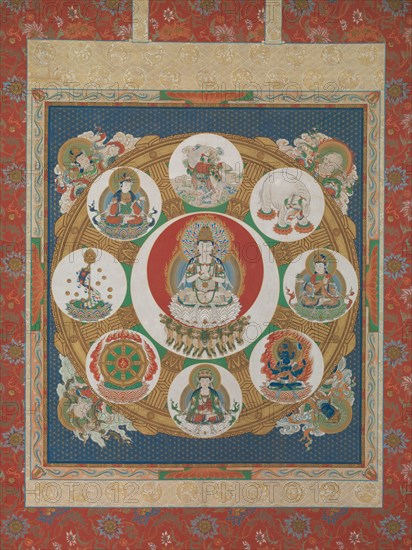
Sujet
Mandala of the One-Syllable Golden Wheel, 18th century. Creator: Unknown.
Légende
Mandala of the One-Syllable Golden Wheel, 18th century. The Mandala of the One-Syllable Golden Wheel (Japanese: Ichiji Kinrin Mandara) envisions the power of a single Sanskrit syllable, the utterance of which calls forth a personification of the cranial protuberance of the Buddha. It is used in rituals for the prevention of disaster, for the expansion of wealth, and for success in love, as well as for assuring safe delivery of children, career success, and propitious weather. The figural representation of the sound sits at the center of the mandala on a lotus pedestal borne by eight lions. It resembles the Buddha Dainichi (Sanskrit: Vairochana) and holds its hands in a sacred gesture known as the wisdom-fist mudra, which symbolizes the non-duality of perfect wisdom and the deluded nature of unenlightened beings. The surrounding figures and forms represent the seven emblems of sovereignty of supreme rulers and the deity Butsugen Butsumo, literally Buddha-eye, Buddha-mother, who crushes ignorance and perceives the essence of all things.
Crédit
Photo12/Heritage Images/Heritage Art
Notre référence
HRM20A35_154
Model release
NA
Property release
NA
Licence
Droits gérés
Format disponible
34,3Mo (6,1Mo) / 25,4cm x 33,9cm / 3001 x 4000 (300dpi)